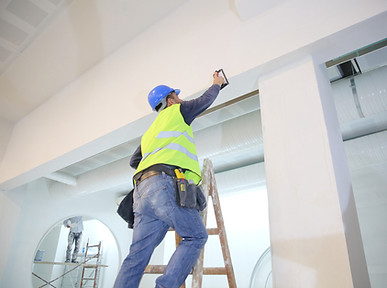Case study:
Innovation and early engagement speeds project delivery by four weeks

Problem
Construction is generally considered to have low levels of innovation when compared to other sectors such as manufacturing. However, the construction supply chain faces dynamic and changing conditions on site, which need to be understood and overcome. This is especially the case for those in the supply chain who have the responsibility of delivery on site.
How these challenges are met by tier 2 and 3 contractors is often not disseminated, leaving lessons to be relearnt by others.
The storage and placement of plasterboard is one such challenge not only for drylining contractors but also for other trades who are often seeking to occupy these same spaces to complete their own tasks. When stored flat, the boards can take up considerable floor space resulting in limited working space or waste from damaged boards. It is also of equal importance that materials are stored safely and in a manner that will not result in harm.
Intervention
Tier 2 and tier 3 drylining contractors engaged in collaborative risk management as an early engagement workshop before commencement of construction works for a large hospital facility. The team considered the challenges they would face on their next project, where they were installing ceilings to 110 rooms on 5 levels on a 6-week programme.
Participants were introduced to a “flow walks” activity where they walk around evaluating and posting issues that block their workflow on site across eight areas of constraints: materials, equipment, safe space, people, information, shared understanding, prior work, and external conditions. This was presented as an early supply chain engagement process that enhances collaborative working and improves reliability of site production. Participants were briefed on the need to assess any disruptions to the flow of work as part of a collaborative risk management approach could help improve the reliability of commitments made in the collaborative plans by the tier 2 contractor.
One of the key obstacles that came up during this early engagement activity as being faced by the team of tier 2 and 3 drylining contractors was the limited rooms available for them to commence work and the limited space available for other trades to instigate their work once materials are placed in the room.

Outcome
During the collaborative risk management activity, the team identified a means by which they could store plasterboards vertically on their longest edge. This had the potential to release valuable floor space, reducing waste hence saving both time and money. The team identified the use of an American product called Rocksteady clips which had historically been used for the quicker installation of plasterboard. This had been used on other projects in conjunction with a UK tier 1 contractor who had assessed their efficacy on the grounds of health and safety and found them to be appropriate and productive.
Impact
The of use Rocksteady clips permitted the tier 2 contractor to preload every other room thereby sequencing the work to get ahead of other trades whilst leaving other rooms available for other trades. The clips enabled plasterboard to be stored safely against walls, rather than flat, which due to their size (2.5 meters to 3.6 meters long), would have been heavy to move for other trades and restrict working space.
Due to the innovative use of the product in conjunction with early engagement in sequencing the works on a previous project, the main contractor was able to hand the project over four weeks ahead of programme.


